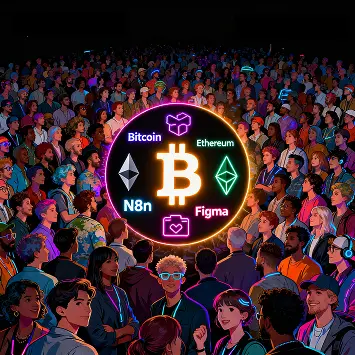As the digital landscape evolves, so does the way marketers approach different types of platforms and technologies. The rise of Web3 is not just a technological shift—it’s a profound change in how we think about Web2 vs Web3 marketing strategies, channels, and the relationship between companies and their audiences. In this article, we’ll explore the key differences between Web2 and Web3 from a marketing perspective, focusing on product marketing, pricing strategies, and promotional strategies. We’ll also consider the classic 4Ps of the marketing mix—Product, Price, Place, and Promotion—and how they apply in the Web3 world.
The Marketing Mix in Web2 vs. Web3
The traditional marketing mix, often referred to as the 4Ps—Product, Price, Place, and Promotion—remains a foundational framework for both Web3 marketing strategies and Web2 performance marketing. However, the execution of these elements shifts significantly in Web3 due to decentralization in marketing, community involvement, and the rise of token-based marketing ecosystems.
In Web2, the 4Ps are typically controlled by the business, with a top-down approach where companies define the product, set prices, choose distribution channels (place), and push promotional strategies to a wide audience. The relationship between the company and the customer is more transactional, with businesses maintaining control over most aspects of the product and customer experience.
In Web3, the 4Ps are decentralized and community-driven. The product often evolves based on community input, pricing is influenced by tokenomics in Web3 marketing, distribution happens on decentralized networks, and promotion focuses on Web3 community building and organic growth. The shift toward user ownership and token-based participation creates a more dynamic and fluid marketing environment, where users are not just customers but also stakeholders and co-creators in the project’s success.
Product Marketing in Web2 vs.Web3
Web2 Product Marketing
In Web2, product marketing tends to be more top-down. Companies build a product based on market research and internal decisions, and then launch it to a pre-defined audience. The product itself is generally static—meaning that once it’s released, the product doesn’t evolve much unless driven by internal decisions from the company. Feedback is usually gathered through user reviews, surveys, or analytics, but users typically have little direct influence over the actual product development process.
Web3 Product Marketing
In Web3, the product is often dynamic and community-driven, fundamentally reshaping blockchain technology marketing. The product is not just a result of internal development; rather, it often evolves in real-time based on community input. Token-based marketing and decentralized applications (dApps) mean that users have a direct say in how the product develops. This fosters a co-creation environment, where users are incentivized to contribute to product development through governance tokens or staking mechanisms.
Several famous Web3 platforms showcase this dynamic, community-driven approach:
MakerDAO
MakerDAO, the platform behind the DAI stablecoin, has an entirely decentralized structure. Holders of MKR, the governance token, propose and vote on crucial decisions about the protocol, such as collateral types, risk parameters, and integration with real-world assets (RWAs). This system allows the community to influence the product’s development and its evolution in response to market needs and user input.
Yearn Finance
Yearn Finance, a yield aggregator, also relies on community governance through its YFI token. The platform allows users to propose new strategies for yield farming, and community votes determine which ones to implement. The evolution of Yearn’s v2 vaults is a direct result of community feedback, showing how user participation can significantly influence the development of the product.
Aave
Aave, a decentralized lending platform, empowers its community with governance rights through AAVE tokens. Users propose changes to collateral types, interest rates, and new features like flash loans. These decisions are made collectively by the community, ensuring that the platform evolves in a way that aligns with user interests and market dynamics.
Token Economy and Its Role in Product Development
The token economy is central to this co-creation model in Web3. Governance and utility tokens give users a direct economic stake in the project, aligning the platform’s success with the user’s interests. This incentivizes users not only to participate in the product but also to shape its future. Tokens provide users with governance rights, allowing them to vote on product features and updates, ensuring that the product develops in a way that benefits the entire community. This democratized model of product development is a stark contrast to the closed-off approach in Web2, where only internal teams shape the product’s future.
Price Strategies in Web2 vs. Web3
Web2 Pricing Strategies
In Web2, pricing strategies are more traditional and often revolve around fixed pricing models, subscription fees, or tiered pricing structures based on product features or services. Pricing is typically determined by market research, competitor analysis, production costs, and supply-demand dynamics. Companies control the pricing and adjust it periodically based on business goals, market conditions, or promotional periods. In many cases, customers pay a flat fee or recurring charges, and their relationship with the company is largely transactional.
Web3 Pricing Strategies
In Web3, pricing strategies are inherently more fluid and dynamic due to the integration of tokenomics in Web3 marketing. The value of tokens, which often represent governance, utility, or access within a platform, fluctuates with market conditions. This introduces a layer of volatility and decentralization into the pricing model. The community, in some cases, has a say in pricing decisions via decentralized governance, such as voting on staking rewards, transaction fees, or the cost of participation in a decentralized network. Pricing in Web3 is not always about paying in traditional fiat currencies but often involves the acquisition and use of native tokens, which can appreciate or depreciate in value based on market forces.
For example, Uniswap charges a percentage fee on every trade made through its decentralized exchange, but these fees can be adjusted via community governance. Similarly, SushiSwap allows its users to stake tokens and earn rewards, where the value of these rewards fluctuates based on the price of the governance token, SUSHI. In both cases, the price is not simply set by the company but is influenced by the broader market and the community’s governance decisions.
Place Strategies
Web2 Place Strategies
In Web2 vs. Web3 Marketing, “place” typically refers to the distribution channels where products or services are made available to consumers. These channels are largely centralized and controlled by companies, often through e-commerce platforms, app stores, websites, or centralized entities like social media networks. For digital products, place may involve platforms like Google Play, the Apple App Store, or centralized e-commerce platforms like Amazon and Shopify. Companies also utilize social media platforms like Facebook, Instagram, and Twitter to distribute content and engage with users. For SaaS products, businesses often rely on their websites or centralized hosting services like AWS (Amazon Web Services) to deliver services directly to customers.
In Web2, these centralized platforms serve as the primary gateways where companies distribute their products and services to a broad audience. They also serve as points of control, where the platform owners can dictate terms and access for both companies and users, creating a more hierarchical and controlled digital landscape.
Web3 Place Strategies
In Web3, place takes on a more decentralized and abstract meaning. Instead of traditional centralized platforms, Web3 projects operate on decentralized networks like Ethereum, Solana, or other blockchain protocols. Distribution happens on decentralized exchanges (DEXs), peer-to-peer networks, or within the metaverse, where there are no central authorities controlling the flow of products or services. Web3 platforms like Uniswap or SushiSwap are examples of decentralized exchanges where users can trade assets without intermediaries.
Additionally, Web3 projects often use decentralized applications (dApps) as their “place” of distribution. These dApps are hosted on blockchain networks and provide access to services like decentralized finance (DeFi), gaming, or NFT marketplaces, where users directly interact with the blockchain to execute transactions. The concept of place in Web3 is more about accessing a decentralized, permissionless ecosystem, where users can engage with products and services without the need for traditional middlemen or platforms.
This decentralization shifts control from centralized entities to communities and networks, creating a more open and accessible digital economy. For example, Decentraland, a virtual metaverse platform, allows users to buy and sell virtual real estate and interact within a decentralized virtual world. The “place” here is not a website or app, but a shared, decentralized digital space where transactions occur through blockchain technology. This new concept of place redefines how products and services are distributed and consumed in the Web3 space.
Top Popular “Places” for Web3 Projects:
- Ethereum Network: The most widely used blockchain platform for decentralized applications (dApps) and DeFi services.
- Solana: Known for its high throughput and low transaction fees, Solana is a key place for dApps, NFT projects, and DeFi platforms.
- Polygon: A layer-2 scaling solution for Ethereum, providing faster and cheaper transactions while maintaining Ethereum’s security.
- Uniswap (DEX): A decentralized exchange that allows users to trade tokens directly from their wallets without a centralized intermediary.
- SushiSwap (DEX): Another decentralized exchange offering token trading and DeFi services with community governance.
- Decentraland: A decentralized metaverse where users can buy, sell, and build on virtual land using blockchain technology.
- OpenSea: A decentralized NFT marketplace where users can buy and sell digital art, collectibles, and other virtual assets.
- Arbitrum: A layer-2 solution for Ethereum designed to improve scalability and reduce transactioncosts for dApps and smart contracts.
- Avalanche: A high-speed blockchain that allows for the creation of custom blockchains (subnets) and decentralized applications (dApps).`
These decentralized “places” allow Web3 projects to operate in a permissionless, trustless environment where the community, rather than centralized gatekeepers, controls access and interaction.
Promotion Strategies in Web2 vs. Web3
Web2 Promotion Strategies
In Web2 vs. Web3, promotion relies heavily on traditional methods like paid advertising (Google Ads, Facebook Ads), SEO, content marketing, and email campaigns. These approaches typically follow a top-down, one-way communication model, where brands broadcast their message to a targeted audience. The focus is on building brand authority and driving customer acquisition through scalable, data-driven methods.
Web3 Promotion Strategies
Web3 approaches promotion differently, with an emphasis on Web3 community building, incentivization, and organic growth. Instead of focusing on traditional advertising channels, Web3 projects leverage decentralized platforms and user engagement through governance and utility tokens. Community members are not only users; they often serve as ambassadors, creators, and decision-makers. This sense of ownership through token-based marketing fosters deeper engagement and loyalty, driving organic promotion as community members actively spread the word about the project.
For example, Axie Infinity, a play-to-earn gaming platform, relied heavily on Discord to build a robust community. Players were incentivized through token rewards to create content, share tips, and help the game evolve. This type of community-driven promotion, where users become advocates and co-creators, is typical in Web3 but rare in Web2.
Marketing Engagement and Community Building in Web3
Web3 companies rely heavily on innovative marketing engagement activities to build and sustain active user bases. Unlike traditional Web2 businesses, where promotion often revolves around passive content consumption or paid advertisements, Web3 companies prioritize active participation and decentralized involvement. Community members aren’t just customers—they are stakeholders, decision-makers, and promoters. This deep sense of involvement turns users into advocates, naturally promoting the project through their actions and engagement.
Here are some common Web3 marketing engagement activities and mechanics that effectively build and promote communities:
Gamified Competitions and Token Incentives
Web3 projects often use gamification to engage their communities in fun, interactive ways that drive organic promotion. Competitions with token rewards or NFT collectibles help foster engagement while simultaneously building a loyal user base. This kind of gamification not only engages users but also turns them into promoters, spreading the project to new audiences.
DAO (Decentralized Autonomous Organization) Voting and Governance Proposals
Allowing community members to actively participate in a project’s decision-making process through DAOs is a powerful form of promotion. When users feel invested in the project’s success through governance tokens, they are more likely to promote the project and invite others to join. This level of engagement builds strong ties between the project and its community, encouraging users to spread the word about their involvement and the value of the project.
Community Bounties and Quests
Bounty programs and quests are another effective way Web3 projects promote themselves by activating their community to take specific actions in exchange for rewards. These tasks, such as creating content, finding bugs, or sharing social media posts, help build brand visibility while incentivizing users to become advocates.
Token-Gated Access and VIP Communities
Another way Web3 companies create exclusive engagement is by implementing token-gated access. Holding a certain amount of governance or utility tokens grants users entry into private channels, exclusive content, or even physical events. This mechanic not only encourages users to acquire and hold tokens but also creates a sense of belonging, which drives loyalty and organic promotion.
AMA (Ask Me Anything) Sessions with Founders and Influencers
AMA sessions are an essential tool for transparency and community engagement in Web3. Hosted on platforms like Telegram, Discord, or Twitter, these sessions allow community members to ask questions directly to project founders or influencers. This direct communication builds trust and excitement, which is crucial for fostering organic promotion.
Memes and Viral Content Campaigns
Web3 projects frequently use memes and viral content to engage their communities and promote themselves organically. Encouraging the community to create and share memes allows the project to spread rapidly across social platforms, reaching new audiences without the need for traditional advertising.
NFT Airdrops and Collectible Rewards
NFT airdrops are another popular engagement and promotional strategy in Web3. By rewarding early supporters or active community members with exclusive NFTs, projects create excitement and drive loyalty. These NFTs often come with functional utility, such as voting rights or special privileges, adding value beyond mere collectibles.
Through these innovative marketing mechanics—whether it’s gamified experiences, governance participation through DAOs, or NFT marketing strategies—Web3 projects drive promotion by turning community members into active participants and advocates. This participatory model fosters long-term loyalty and organic growth, creating a form of promotion that is deeply rooted in community engagement and ownership.
Conclusion of Web2 vs. Web3 Marketing
From a marketing perspective, the differences between Web2 vs Web3 marketing are profound, particularly in how products are developed and promoted. In Web2, marketing is often a one-way conversation where products are defined and developed internally, with promotion focused on broadcasting to an audience. In Web3, marketing becomes a two-way street, with users playing an integral role in product development, promotion, and governance.
The essence of the 4Ps—Product, Price, Place, and Promotion—remains central, but their implementation is radically different in Web3. Community engagement, decentralized governance, and the token economy reshape how we think about blockchain and marketing strategies. In this new era, marketers must adapt to more transparent, dynamic, and community-driven approaches to successfully navigate the Web3 landscape.








